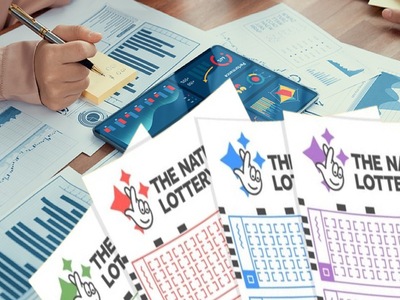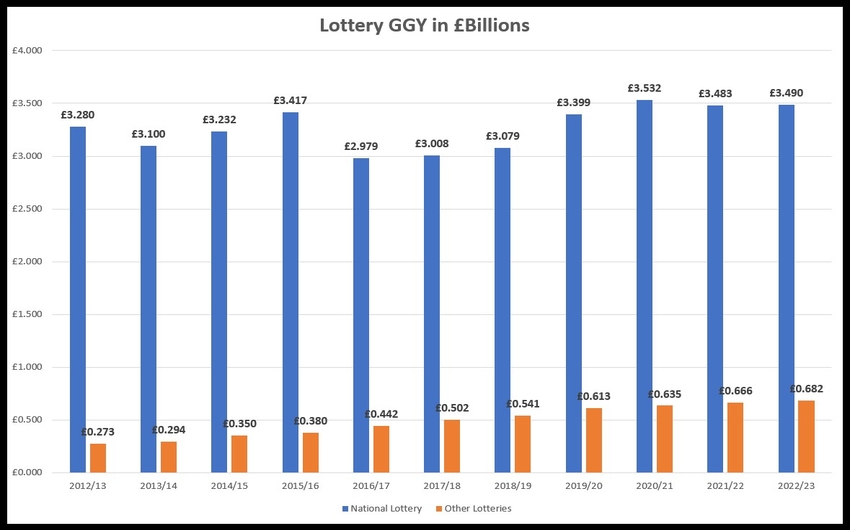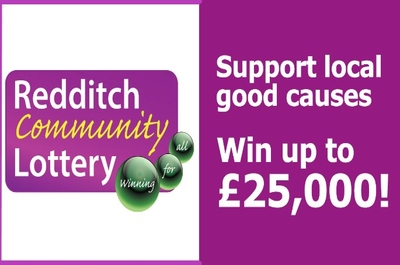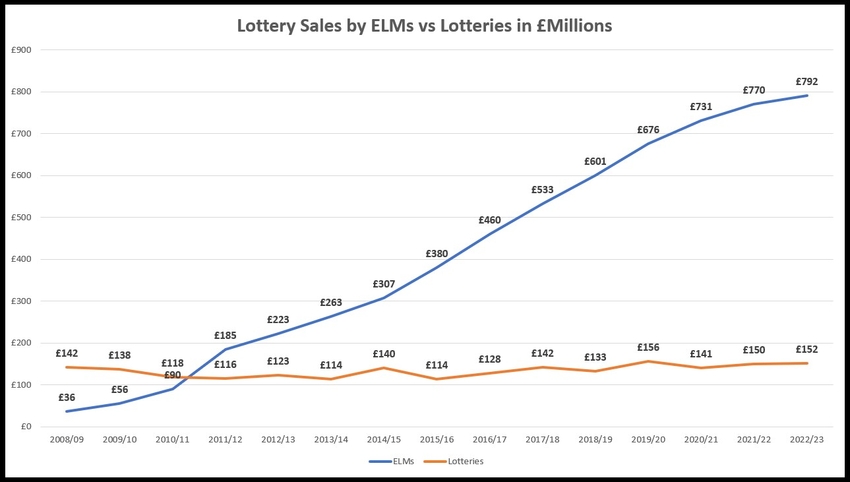 The UKGC keep the data on the National Lottery and all other lotteries in the UK separate, which at first may seem like an odd thing to do, but remember, the National Lottery is run on behalf of the government, while all other smaller lotteries are run by independent companies or charities.
The UKGC keep the data on the National Lottery and all other lotteries in the UK separate, which at first may seem like an odd thing to do, but remember, the National Lottery is run on behalf of the government, while all other smaller lotteries are run by independent companies or charities.
This actually gives us some useful insight into how lottery players think and behave between the two categories, because while the National Lottery is known by pretty much everybody in the country, the rest of the lotteries are not.
Or at least they haven’t been in the past.
There are more than 200 smaller lotteries running in the UK, all raising money for good causes as well as paying out very welcome cash prizes to the winners who buy the lucky tickets or scratch cards.
The lottery landscape is changing too, with 3rd party management companies taking more of the load from the organisations the lotteries are running on behalf of, and with players seemingly more engaged with these smaller competitions than ever.
Gross Gambling Yield (GGY) and Revenues of Lotteries in the UK

If we look at the GGY of the National lottery compared with the GGY of all other UK lotteries, one thing is immediately apparent: one is doing increasingly well, and the other, isn’t.
There is an uninterrupted year on year average increase of around 10% with other lotteries, while the GGY of the National Lottery has barely increased at all in that same period of time.
So in total, other lotteries have increased their GGY by 149.81% (£273 million in 2013 to £682 million in 2023), and the National Lottery has grown just 6.40% (£3.280 billion in 2013 to £3.490 billion in 2023).
You can also see that the National Lottery’s GGY has been much more up and down than the other lotteries, which have gone up in a straight line.
To me, it seems that not only have smaller, less mainstream lotteries become more popular, but when you understand how the National Lottery works, it seems that they have been messing around with their distribution a lot more too.
 If you consider that smaller lotteries tend to be set up to help specific charities, there is no 3rd party controlling the profit levels outside of what goes back into the charity. On the other hand, the National Lottery is run by a 3rd party (Camelot for a long time, but Allwyn since 2024), and they have huge expenses to pay in terms of marketing, not to mention profit for themselves, and that’s before prizes and money paid out to good causes.
If you consider that smaller lotteries tend to be set up to help specific charities, there is no 3rd party controlling the profit levels outside of what goes back into the charity. On the other hand, the National Lottery is run by a 3rd party (Camelot for a long time, but Allwyn since 2024), and they have huge expenses to pay in terms of marketing, not to mention profit for themselves, and that’s before prizes and money paid out to good causes.
I went into more detail about this on the main data and trends page.
However, one other thing that is evident from the chart is that other lotteries are not only growing, but taking market share from the National Lottery.
Perhaps they think they have a better chance of winning these smaller lotteries, and perhaps that is because the marketing for these smaller lotteries has improved, which, if that is the case, will have something to do with the External Lottery Managers helping to run them.
External Lottery Managers Increasingly Responsible for Sales

The thing about a lot of these smaller lotteries, is that they are run on behalf of charities who are too small to handle things themselves.
Even when big businesses run lotteries to raise money for charity (like Poundland or WHSmith who have their own scratchcards etc), they don’t have the expertise or infrastructure to do it themselves.
What tends to happen then, is they turn to External Lottery Managers, or ELMs, to run things on their behalf.
As the number of ELM run lotteries have increased, so have the total annual sales generated from these lotteries, but what has also happened is the percentage of sales raised by the ELM over the lotteries themselves has increased.
This shows that organisations are increasingly turning to ELMs to run all, or at least a large proportion, of the lotteries on their behalf.
Year by year the percentages raised by each side has widened as follows:
| Year | Lotteries Sales % | ELM Sales % |
|---|---|---|
| 22/23 | 16.1% | 83.9% |
| 21/22 | 16.3% | 83.7% |
| 20/21 | 16.2% | 83.8% |
| 19/20 | 18.8% | 81.2% |
| 18/19 | 18.2% | 81.8% |
| 17/18 | 21% | 79% |
| 16/17 | 21.8% | 78.2% |
| 15/16 | 23.1% | 76.9% |
| 14/15 | 31.3% | 68.7% |
| 13/14 | 30.2% | 69.8% |
| 12/13 | 35.5% | 64.5% |
| 11/12 | 38.5% | 61.5% |
| 10/11 | 57% | 43% |
| 09/10 | 71.2% | 28.8% |
| 08/09 | 79.6% | 20.4% |
The arrangement will be different for each client the external lottery manager picks up, but basically the client can ask them to handle everything including all of the marketing and sales, or they can split the load.
As you can see from the table, the trend for a long time was that the lotteries themselves were responsible for the majority of the sales, but over time the ELMs became more responsible for overall sales numbers.
In fact, if it wasn’t for the sales made by the ELMs, the lotteries wouldn’t be making any progress since the sales accounted for by lotteries themselves has been stagnant.
This is probably because the charities and other organisations only have limited time and resources with which to promote their lotteries, whereas ELMs have invested in their own technology and marketing abilities, enabling them to increase sales across all of the lotteries they are responsible for.
This works for the charities and organisations because although the ELMs will be earning an increased revenue through commission structures, it still means much more money is flowing into the charities than they could manage without the ELMs.
I was surprised to learn how little of the money a charity actually keeps from the lotteries they run actually.
One particular ELM, Rieves Lotteries, states that while around 42% of the money taken is paid out in prize money, only about 20p in the pound actually ends up in the pockets of the charity. They raised £1,385,822 from 25 lotteries in 2022, and of that just £277,164.40 went to the charity the lottery was run on behalf of.
The other 38% went to expenses such as VAT, printing and marketing costs, retailer commission, and Rieves’ margin. These lotteries cost money to run, and the ELM can’t do it for free so these expenses are understandable, but it was still a shock to see the numbers.
Again though, without those sales via the ELMs, those lotteries would be brining in a lot less.
